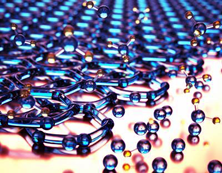IR Spectroscopy Gets Better with Graphene Sensor

In one of the firsts, researchers from Ecole Polytechnique Federale De Lausanne (EPFL) and The Institute of Photonic Sciences (ICFO) have created a sensor made of graphene. The new sensor is capable of detecting biomolecules like proteins and drugs.
The research team has exploited the optical and electrical properties of unilayer graphene nanomaterial to create a molecule sensor. The sensor is used to improve the sensitivity of conventional infrared absorption spectroscopy. Standard IR spectroscopy relies on bombarding the sample with IR spectrum of electromagnetic radiations and detecting the vibrations emitted by different molecules in the sample. While this technique has proven effective with larger molecule sizes, there is more to be desired for nanosized molecules as the vibrations emitted by the nanosized molecules are very small in comparison to the incident IR wavelength of 6 microns.
The research team has found that by using geometric graphene structures they can increase the efficiency of IR spectroscopy, enabling easy analysis of nanosized molecules. The new method involves attaching the analyte molecules on graphene surface before subjecting it to the analysis process.
 The nanomolecules are first etched onto a graphene surface by using electronic beams and etching it with oxygen ions. During analysis, the incident IR beam will cause excitation among the electrons present in graphene to create Localized Plasmon Resonance. The Localized Plasmon Resonance creates tiny spots of IR radiations which corresponds to dimensions of actual target molecule.
The nanomolecules are first etched onto a graphene surface by using electronic beams and etching it with oxygen ions. During analysis, the incident IR beam will cause excitation among the electrons present in graphene to create Localized Plasmon Resonance. The Localized Plasmon Resonance creates tiny spots of IR radiations which corresponds to dimensions of actual target molecule.
Apart from identifying the presence of nanosized molecules, graphene based IR absorption spectrometry can also be used to identify the bonds that are holding the atoms together and overall structural health of the nanoscale molecule. By using this technique, analysis of biomolecules can be made without modifying the sample which will be helpful for medical research and drug discovery applications.
Full report about this research is available on the Science Magazine under the title — ” Mid-infrared plasmonic biosensing with

